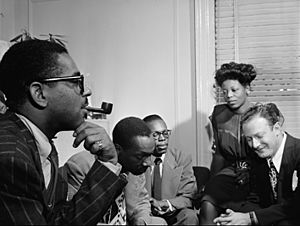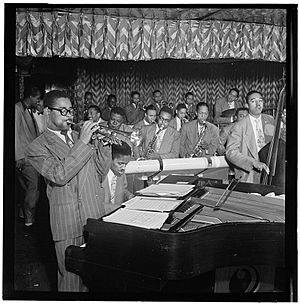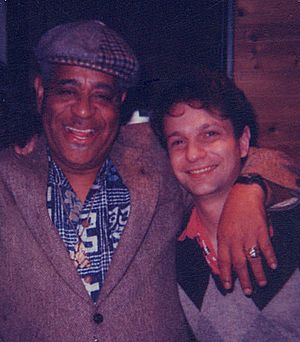Dizzy Gillespie facts for kids
Quick facts for kids
Dizzy Gillespie
|
|
|---|---|
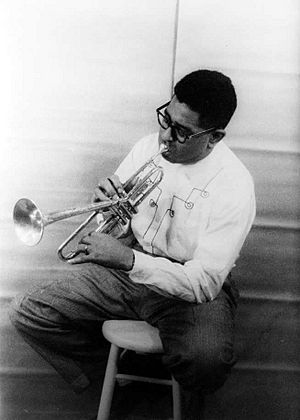
Dizzy Gillespie in 1955
|
|
| Background information | |
| Birth name | John Birks Gillespie |
| Born | October 21, 1917 Cheraw, South Carolina, U.S. |
| Died | January 6, 1993 (aged 75) Englewood, New Jersey, U.S. |
| Genres | Jazz |
| Occupation(s) | Musician, composer |
| Instruments | Trumpet |
| Years active | 1935–1993 |
| Associated acts | Charlie Parker, Cab Calloway |
John Birks "Dizzy" Gillespie (October 21, 1917 – January 6, 1993) was an amazing American jazz trumpet player, bandleader, singer, and composer. He was one of the most important people in the history of jazz music. Dizzy helped create a new style of jazz called "bebop." He was known for his bent trumpet and his puffy cheeks when he played!
Contents
Early Life
Dizzy Gillespie was born in Cheraw, South Carolina. He was the youngest of nine children. His father, James, was a local bandleader. This meant that musical instruments were always around for the children to play. Sadly, Dizzy's father passed away when Dizzy was only ten years old.
Dizzy taught himself to play both the trombone and the trumpet by the time he was twelve. He was a natural talent! He even earned a music scholarship to the Laurinburg Institute in North Carolina. He studied there for two years. After that, his family moved to Philadelphia.
Music Career
Starting Out
Dizzy Gillespie got his first professional music job in 1935. He played with the Frank Fairfax Orchestra. Later, he joined other famous orchestras, like Edgar Hayes' and Teddy Hill's bands. In 1937, he took over as the main trumpet player for Teddy Hill's band.
In 1939, Dizzy joined Cab Calloway's orchestra. With this band, he recorded one of his first songs, "Pickin' the Cabbage." While playing with Calloway, Dizzy also started writing music for other big bands. He even played with Ella Fitzgerald's orchestra in 1942.
In 1943, Dizzy joined the Earl Hines band. Then, he joined Billy Eckstine's big band. Here, he met up again with Charlie Parker. They became very important partners in jazz. In 1945, Dizzy left Eckstine's band. He wanted to play with a "small combo." This usually meant a group of five musicians: trumpet, saxophone, piano, bass, and drums.
The Rise of Bebop
Bebop was the first truly modern style of jazz. At first, it was not very popular. But new musicians like Charlie Parker, Thelonious Monk, and Dizzy Gillespie created a whole new way of playing music. Their songs, like "Groovin' High" and "Salt Peanuts," sounded very different. They had new harmonies and rhythms compared to the popular swing music of the time.
Dizzy was a great teacher. He showed many young musicians on 52nd Street in New York how to play this new jazz style. Some of these students included Miles Davis and Max Roach.
After working with Charlie Parker, Dizzy formed his own successful big band. He and his band worked hard to make bebop popular. Dizzy became a symbol of this exciting new music. He often performed as a solo artist with Norman Granz's Jazz at the Philharmonic. He also starred in a musical film called Jivin' in Be-Bop in 1946.
In 1956, Dizzy's band went on a special tour for the U.S. government. They traveled to the Middle East. People all over the world loved their music. This tour earned Dizzy the nickname "the Ambassador of Jazz." He continued to lead his big band, playing across the United States. His band even recorded a live album at the 1957 Newport Jazz Festival. Dizzy stayed true to the bebop style for his entire career.
Afro-Cuban Jazz
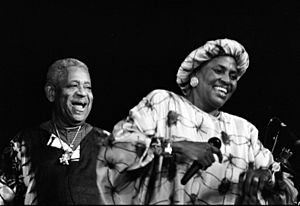
In the late 1940s, Dizzy Gillespie also became very involved in Afro-Cuban music. This style of jazz uses traditional Afro-Cuban rhythms. Dizzy helped to make Afro-Cuban jazz grow and become popular.
Afro-Cuban jazz was a big hit because its unique rhythms made people want to dance. Dizzy's most famous Afro-Cuban songs are "Manteca" and "Tin Tin Deo." He wrote both of these with Chano Pozo.
Later Years and Legacy
In the 1980s, Dizzy led the United Nation Orchestra. Famous singers like Flora Purim toured with this orchestra. She said Dizzy helped her understand jazz even better. David Sánchez, another great musician, also toured with the group. Both Flora and David were later nominated for Grammy awards.
Dizzy was incredibly busy in 1989. He gave 300 concerts in 27 different countries! He also played in 100 cities across the U.S. He appeared in three TV specials, performed with two symphony orchestras, and recorded four albums. What an amazing year!
Personal Life
Dizzy Gillespie met a dancer named Lorraine Willis in August 1937. They were married on May 9, 1940. They stayed married until Dizzy's death in 1993.
Dizzy Gillespie became a member of the Bahá'í Faith in 1968. He was one of the most famous followers of this religion. Dizzy often talked about the Bahá'í Faith when he traveled around the world. Today, weekly jazz sessions are held in his honor at the New York Bahá'í Center.
His Final Years
Dizzy Gillespie passed away on January 6, 1993. He was 75 years old. He died from pancreatic cancer.
Dizzy had two funerals. One was a Bahá'í funeral, as he had wished. His closest friends and fellow musicians attended this one. The second funeral was open to the public. It was held at the Cathedral of St. John the Divine in New York. This allowed everyone who loved his music to say goodbye.
Cool Facts About Dizzy
- Dizzy started playing the piano when he was only four years old.
- He dreamed of becoming a jazz musician after hearing his idol, Roy Eldridge, play on the radio.
- He was nicknamed "Dizzy" because of his energetic and sometimes funny actions during his performances.
- Dizzy did not fight in World War II.
- He helped change American jazz from the swing style to the new "bebop" sound.
- Along with Charlie Parker, he was a key figure in creating modern jazz.
- In 1960, he was added to Down Beat magazine's Jazz Hall of Fame.
- In 1948, Dizzy was in a bicycle accident. After that, he couldn't hit a very high note on his trumpet anymore.
- On January 6, 1953, at a party, his trumpet's bell accidentally got bent upwards. He loved the sound so much that he had special trumpets made with a 45-degree bent bell. This became his famous trademark!
- During the 1964 U.S. presidential campaign, Dizzy jokingly said he would run for president. He promised that if he won, the White House would be renamed the "Blues House."
- He published his autobiography, To Be or Not to Bop, in 1979.
- Dizzy's voice was featured in many animated films, like The Hole and The Hat.
- He also made guest appearances on popular TV shows like The Cosby Show, Sesame Street, and The Muppet Show.
- In 1982, Dizzy had a small part in Stevie Wonder's hit song "Do I Do".
- He was honored as a traditional chief in Nigeria.
- He has a star on the Hollywood Walk of Fame at 7057 Hollywood Boulevard.
Dizzy's Words of Wisdom
- “The idea of life is to give and receive.”
- "I don't care much about music. What I like is sounds."
- "The basic thing about jazz music is putting the notes to rhythm, not the other way around.... You can take just one note and put all kinds of different rhythms to the note and with just that one note everybody is clapping their hands and dancing and shouting."
Awards and Honors
- Dizzy received the Ordre des Arts et des Lettres, which is France's highest cultural award.
- In 1989, he was named a special professor by the University of California. He also received his fourteenth honorary doctoral degree from the Berklee College of Music.
- He was given the Grammy Lifetime Achievement Award in the same year.
- In 1990, Dizzy received the Kennedy Center Honors Award. This was for his 50 years of amazing work as a composer, performer, and bandleader.
- In 1993, he received the Polar Music Prize in Sweden.
- In 2002, after his death, Dizzy was added to the International Latin Music Hall of Fame. This was for his important work in Afro-Cuban music.
Images for kids
-
Gillespie in concert, Deauville, Normandy, France, July 1991
See also
 In Spanish: Dizzy Gillespie para niños
In Spanish: Dizzy Gillespie para niños


